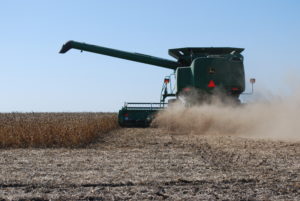I used to think that the more years I farmed, the more experienced I became. With that experience, the less shocked I would be at certain scenarios as I should have “seen them all.” Then reality happens and I am reminded that I still have a great deal to learn when trying to discern our volatile markets. Let me shed a little light on how today’s market fiasco affects crop insurance coverage for 2016.
First of all, I have seen more variation in corn crop conditions this season, within just a few miles – sometimes in the same section, than I can remember in any previous year. I have walked fields that could easily yield over 150 bpa (bushels per acre), while a field across the road will have a hard time achieving 75 bpa. It seems that in one field it paid to till, and a mile down the road it had a negative impact. Typically, our corn yields are significantly higher than soybeans compared to national averages, but this year, with some timely August rains, soybean yields could be well above the historical corn/soybean yield ratio.
This Spring, both corn and soybeans were under price pressure as we set our crop insurance base prices with both crops well below the 2015 price guarantees. Corn experienced a short lived summer rally in late June that left prices well above our spring price, then rapidly retreated to levels that make producers cringe and buyers smile. Soybeans, on the other hand, initiated a rally that, even after softening, is still well above 2015’s levels.
Most market forecasts told producers that it would essentially be impossible to make money raising soybeans this season and for farmers to be sure to use any tools available to minimize their losses. Soybeans could well turn out to be the one crop that turns a profit in 2016 – if we accomplish the current yield estimation and still have our current prices.
Corn producers who had a 120 bu APH (actual production history) and selected a 75% Revenue Protection coverage level for crop insurance coverage were guaranteed 90 bpa or roughly $347 per acre of revenue coverage on their farm. If the current trend in corn prices holds through harvest (about 15% lower than the crop insurance spring projected price), that dollar coverage divided by a lower harvest price makes his new yield coverage 104bpa (about 15% higher than the projected price).
Soybeans on the other hand have experienced a price rally and so revenue coverage will go up to reflect the higher value of harvested soybeans. A producer who has a 36 bu APH with 75% coverage had about $240 /acre coverage. If the current price holds through harvest, his coverage will go up to $273 per acre. Given the outlook for soybean harvest in Beadle County we should be marketing up to our guaranteed bushels at the higher current levels. If market history rings true and my predictions follow the past years’ outcomes, every producer should do the opposite of what I say as the price may skyrocket to $12/bu!
One last thought, if ever we need to have a yield monitor, it is a season like this when we can discover the true winning hybrids and best management practices to use on our farms. Contact us about YIELDSENSE, a yield monitoring system that is available for your combine that will help make the best possible decisions for 2017. Let us help you use the tools you already have to identify what things worked and what didn’t. It is one of the few factors that is truly in our control.
Image Credit: United Soybean Board
